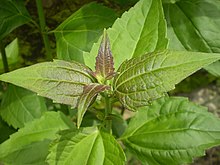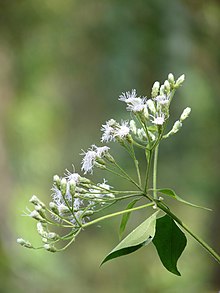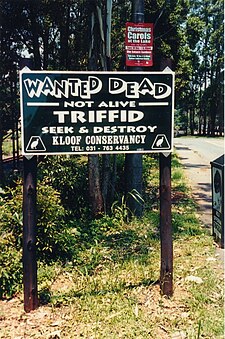Chromolaena odorata
| Chromolaena odorata | |
|---|---|

| |
| Scientific classification | |
| Kingdom: | Plantae |
| Clade: | Tracheophytes |
| Clade: | Angiosperms |
| Clade: | Eudicots |
| Clade: | Asterids |
| Order: | Asterales |
| Family: | Asteraceae |
| Genus: | Chromolaena |
| Species: | C. odorata
|
| Binomial name | |
| Chromolaena odorata | |
| Synonyms[1] | |
|
Synonymy
| |


Chromolaena odorata is a tropical and subtropical species of flowering shrub in the sunflower family. It is native to the Americas, from Florida and Texas in the United States south through Mexico and the Caribbean[2][3] to South America.[4] It has been introduced to tropical Asia, west Africa, and parts of Australia.[5][6][7]
Common names include Siam weed, Christmas bush, devil weed, camphor grass, common floss flower, communist green and triffid.[8]
Description
Chromolaena odorata is a rapidly growing perennial herb. It is a multi-stemmed shrub to 2.5 m (100 inches) tall in open areas. It has soft stems but the base of the shrub is woody. In shady areas it becomes etiolated and behaves as a creeper, growing on other vegetation. It can then become up to 10 m (33 feet) tall. The plant is hairy and glandular and the leaves give off a pungent, aromatic odour when crushed. The leaves are opposite, triangular to elliptical with serrated edges. Leaves are 4–10 cm long by 1–5 cm wide (up to 4 x 2 inches). Leaf petioles are 1–4 cm long. The white to pale pink tubular flowers are in panicles of 10 to 35 flowers that form at the ends of branches. The seeds are achenes and are somewhat hairy. They are mostly spread by the wind, but can also cling to fur, clothes and machinery, enabling long distance dispersal. Seed production is about 80000 to 90000 per plant. Seeds need light to germinate. The plant can regenerate from the roots. In favorable conditions the plant can grow more than 3 cm per day.[9]
Classification
It was earlier taxonomically classified under the genus Eupatorium, but is now considered more closely related to other genera in the tribe Eupatorieae.[10]
Uses

A recent review indicates that the ethno-pharmacological, funcigicidal, nematicidal importance of the plant and its use as a fallow species and as a soil fertility improvement plant in the slash and burn rotation system of agriculture has contributed to its continued use and spread in Nigeria.[11][12]
Invasive species

Chromolaena odorata is considered an invasive weed of field crops and natural environments in its introduced range.[13] It has been reported to be the most problematic invasive species within protected rainforests in Africa.[14] In Western Africa it prevents regeneration of tree species in areas of shifting cultivation. It affects species diversity in southern Africa. The plant's flammability affects forest edges.[15]
In Sri Lanka it is a major weed in disturbed areas and coconut plantations.[8]
Control
Biological control with a defoliating artiid was attempted in the 1970s.[16]
In the Ashanti region of Ghana Pareuchaetes pseudoinsulata was introduced to some effect in a pilot study in the Ashanti region.[17]
A renewed call for coordinated biological control effort in Nigeria was made in 2014, to attempt to bring the plant back into an ecological equilibrium.[11]
In Australia a systematic eradication programme with herbicide has been initiated.[18]
History of introduction
In the nineteenth century Chromolaena odorata escaped from the botanical gardens at Dacca (India), Java (Indonesia) and Peradeniya (Sri Lanka). In Western Africa the plant was accidentally introduced with forestry seeds. It was introduced as an ornamental in Southern Africa, and was introduced to Ivory Coast in 1952 to control Imperata grasses. It was first found in Queensland, Australia in 1994 and was perhaps introduced with foreign pasture seeds.[19] It is locally called Communist Pacha in the south Indian state Kerala as the plant was introduced there in the 1950s, the era when the Communists formed a government.
Toxicity
Chromolaena odorata contains carcinogenic pyrrolizidine alkaloids.[20] It is toxic to cattle.[8] It can also cause allergic reactions.[21] Recent research has shown the plant is larvicidal against all major mosquito vectors.[22]
See also
- John Wyndham's The Day of the Triffids— the post-apocalyptic novel from which the plant receives one of its colloquial names
References
- ^ "Chromolaena odorata (L.) R.M.King & H.Rob.". The Global Compositae Checklist (GCC) – via The Plant List. Note that this website has been superseded by World Flora Online
- ^ Nesom, Guy L. (2006). "Chromolaena odorata". In Flora of North America Editorial Committee (ed.). Flora of North America North of Mexico (FNA). Vol. 21. New York and Oxford: Oxford University Press – via eFloras.org, Missouri Botanical Garden, St. Louis, MO & Harvard University Herbaria, Cambridge, MA.
- ^ "Chromolaena odorata". County-level distribution map from the North American Plant Atlas (NAPA). Biota of North America Program (BONAP). 2014.
- ^ "Chromolaena odorata (L.) R. M. King & H. Rob". Germplasm Resources Information Network. Agricultural Research Service, United States Department of Agriculture. Retrieved 15 July 2017.
- ^ Chen, Yilin; Kawahara, Takayuki; Hind, D. J. Nicholas. "Chromolaena odorata". Flora of China. Vol. 20–21 – via eFloras.org, Missouri Botanical Garden, St. Louis, MO & Harvard University Herbaria, Cambridge, MA.
- ^ "Chromolaena odorata (L.) R.M. King & H. Rob.". Tropicos. Missouri Botanical Garden.
- ^ Atlas of Living Australia
- ^ a b c Lalith Gunasekera, Invasive Plants: A guide to the identification of the most invasive plants of Sri Lanka, Colombo 2009, p. 116–117.
- ^ Lalith Gunasekera, Invasive Plants: A guide to the identification of the most invasive plants of Sri Lanka, Colombo 2009, p. 116–117. ”Siam weed or chromolaena (Chromolaena odorata)” Weed Management Guide at http://www.environment.gov.au/biodiversity/invasive/weeds/publications/guidelines/alert/pubs/c-odorata.pdf and Pierre Binggeli ”Chromolaena odorata (L.) King & Robinson (Asteraceae)”, 1997, at http://pages.bangor.ac.uk/~afs101/iwpt/web-sp4.htm
- ^ GJ Schmidt; EE Schilling (May 2000). "Phylogeny and Biogeography of Eupatorium (Asteraceae: Eupatorieae) Based on Nuclear ITS Sequence". American Journal of Botany. 87 (5). Botanical Society of America: 716–726. doi:10.2307/2656858. JSTOR 2656858. PMID 10811796.
- ^ a b Uyi OO, Ekhator F, Ikuenobe CE, Borokini TI, Aigbokhan EI, Egbon IN, Adebayo AR, Igbinosa IB, Okeke CO, Igbinosa EO, Omokhua GA. 2014. Chromolaena odorata invasion in Nigeria: A case for coordinated biological control Management of Biological Invasions (2014) 5(4): 377–393. [1]
- ^ The plant is referred to as "rompe saragüey" by practitioners of Santeria, who use it for spiritual purposes. This use was famously mentioned in the salsa (music) song "Rompe Saragüey" by Héctor Lavoe.
- ^ "Siam weed or chromolaena (Chromolaena odorata)" Weed Management Guide at http://www.environment.gov.au/biodiversity/invasive/weeds/publications/guidelines/alert/pubs/c-odorata.pdf and Pierre Binggeli ”Chromolaena odorata (L.) King & Robinson (Asteraceae)”, 1997, at http://pages.bangor.ac.uk/~afs101/iwpt/web-sp4.htm
- ^ TT Struhsaker; PJ Struhsaker; KS Siex (May 2005). "Conserving Africa's rain forests: problems in protected areas and possible solutions" (PDF). Biological Conservation. 123 (1): 45–54. doi:10.1016/j.biocon.2004.10.007. ISSN 0006-3207.
- ^ Pierre Binggeli ”Chromolaena odorata (L.) King & Robinson (Asteraceae)”, 1997, at http://pages.bangor.ac.uk/~afs101/iwpt/web-sp4.htm
- ^ Gunasekera, L. (2009). Invasive Plants: A guide to the identification of the most invasive plants in Sri Lanka. Colombo. 116-117
- ^ "Archived copy". Archived from the original on 2011-04-09. Retrieved 2015-09-11.
{{cite web}}: Unknown parameter|deadurl=ignored (|url-status=suggested) (help)CS1 maint: archived copy as title (link) - ^ Pierre Binggeli ”Chromolaena odorata (L.) King & Robinson (Asteraceae)”, 1997, at http://pages.bangor.ac.uk/~afs101/iwpt/web-sp4.htm ”Siam weed or chromolaena (Chromolaena odorata)” Weed Management Guide at http://www.environment.gov.au/biodiversity/invasive/weeds/publications/guidelines/alert/pubs/c-odorata.pdf
- ^ Pierre Binggeli ”Chromolaena odorata (L.) King & Robinson (Asteraceae)”, 1997, at http://pages.bangor.ac.uk/~afs101/iwpt/web-sp4.htm
- ^ Fu, P.P., Yang, Y.C., Xia, Q., Chou, M.C., Cui, Y.Y., Lin G., "Pyrrolizidine alkaloids-tumorigenic components in Chinese herbal medicines and dietary supplements", Journal of Food and Drug Analysis, Vol. 10, No. 4, 2002, pp. 198-211 [2][permanent dead link]
- ^ ”Siam weed or chromolaena (Chromolaena odorata)” Weed Management Guide at http://www.environment.gov.au/biodiversity/invasive/weeds/publications/guidelines/alert/pubs/c-odorata.pdf
- ^ Gade, S; Rajamanikyam, M; Vadlapudi, V; Nukala, KM; Aluvala, R; Giddigari, C; Karanam, NJ; Barua, NC; Pandey, R; Upadhyayula, VS; Sripadi, P; Amanchy, R; Upadhyayula, SM (2017). "Acetylcholinesterase inhibitory activity of stigmasterol & hexacosanol is responsible for larvicidal and repellent properties of Chromolaena odorata". Biochimica et Biophysica Acta. 1861 (3): 541–550. doi:10.1016/j.bbagen.2016.11.044.
Further reading
- Pink, A. (2004). Gardening for the Million. Project Gutenberg Literary Archive Foundation.
- Raimundo, R. L. G., R. L. Fonseca, R. Schachetti-Pereira, A. T. Peterson & Thomas Michael Lewinsohn, 2007.Native and Exotic Distributions of Siamweed (Chromolaena odorata) Modeled Using the Genetic Algorithm for Rule-Set Production. Weed Science, 55 (1): 41–48 | Abstract[permanent dead link]
- ”Siam weed or chromolaena (Chromolaena odorata)”, Weed Management Guide, ISBN 1-920932-36-4. At http://www.environment.gov.au/biodiversity/invasive/weeds/publications/guidelines/alert/pubs/c-odorata.pdf
- Pierre Binggeli ”Chromolaena odorata (L.) King & Robinson (Asteraceae)”, 1997, at http://pages.bangor.ac.uk/~afs101/iwpt/web-sp4.htm
- Lalith Gunasekera, Invasive Plants: A guide to the identification of the most invasive plants of Sri Lanka, Colombo 2009, p. 116–117.
External links
 Media related to Chromolaena odorata at Wikimedia Commons
Media related to Chromolaena odorata at Wikimedia Commons Data related to Chromolaena odorata at Wikispecies
Data related to Chromolaena odorata at Wikispecies- Queensland Government Factsheet
- Dressler, S.; Schmidt, M. & Zizka, G. (2014). "Chromolaena odorata". African plants – a Photo Guide. Frankfurt/Main: Forschungsinstitut Senckenberg.
- Chromolaena
- Eupatorieae
- Invasive plant species
- Invasive plant species in South Africa
- Medicinal plants of Central America
- Flora naturalised in Australia
- Flora of the Caribbean
- Flora of Texas
- Flora of Florida
- Flora of Mexico
- Flora of South America
- Plants described in 1759
- Invasive plant species in Sri Lanka
- Medicinal plants of North America
